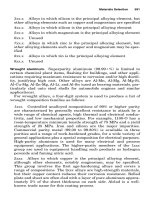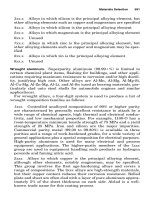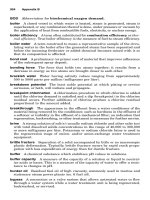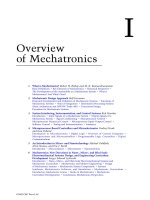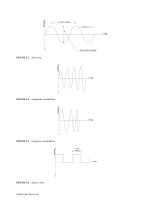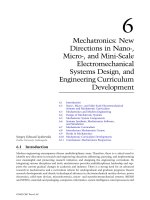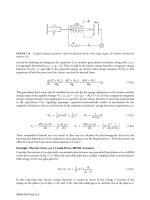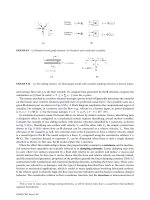Crc Press Mechatronics Handbook 2002 By Laxxuss Episode 1 Part 1 pptx
Bạn đang xem bản rút gọn của tài liệu. Xem và tải ngay bản đầy đủ của tài liệu tại đây (658.54 KB, 4 trang )
I
Overview
of Mechatronics
1 What is Mechatronics?
Robert H. Bishop and M. K. Ramasubramanian
Basic Definitions • Key Elements of Mechatronics • Historical Perspective •
The Development of the Automobile as a Mechatronic System • What is
Mechatronics? And What’s Next?
2 Mechatronic Design Approach
Rolf Isermann
Historical Development and Definition of Mechatronic Systems • Functions of
Mechatronic Systems • Ways of Integration • Information Processing Systems
(Basic Architecture and HW/SW Trade-offs) • Concurrent Design
Procedure for Mechatronic Systems
3 System Interfacing, Instrumentation, and Control Systems
Rick Homkes
Introduction • Input Signals of a Mechatronic System • Output Signals of a
Mechatronic System • Signal Conditioning • Microprocessor Control •
Microprocessor Numerical Control • Microprocessor Input–Output Control •
Software Control • Testing and Instrumentation • Summary
4 Microprocessor-Based Controllers and Microelectronics
Ondrej Novak
and Ivan Dolezal
Introduction to Microelectronics • Digital Logic • Overview of Control Computers •
Microprocessors and Microcontrollers • Programmable Logic Controllers • Digital
Communications
5 An Introduction to Micro- and Nanotechnology
Michael Goldfarb,
Alvin Strauss, and Eric J. Barth
Introduction • Microactuators • Microsensors • Nanomachines
6 Mechatronics: New Directions in Nano-, Micro-, and Mini-Scale
Electromechanical Systems Design, and Engineering Curriculum
Development
Sergey Edward Lyshevski
Introduction • Nano-, Micro-, and Mini-Scale Electromechanical Systems and
Mechatronic Curriculum • Mechatronics and Modern Engineering • Design
of Mechatronic Systems • Mechatronic System Components • Systems
Synthesis, Mechatronics Software, and Simulation • Mechatronic Curriculum •
Introductory Mechatronic Course • Books in Mechatronics • Mechatronic
Curriculum Developments • Conclusions: Mechatronics Perspectives
©2002 CRC Press LLC
systems appeared in Greece from 300 to 1 B.C. with the development of float regulator mechanisms [7].
Two important examples include the water clock of Ktesibios that used a float regulator, and an oil lamp
devised by Philon, which also used a float regulator to maintain a constant level of fuel oil. Later, in the
first century, Heron of Alexandria published a book entitled
Pneumatica
that described different types of
water-level mechanisms using float regulators.
In Europe and Russia, between seventeenth and nineteenth centuries, many important devices were
invented that would eventually contribute to mechatronics. Cornelis Drebbel (1572–1633) of Holland
devised the temperature regulator representing one of the first feedback systems of that era. Subsequently,
Dennis Papin (1647–1712) invented a pressure safety regulator for steam boilers in 1681. Papin’s pressure
regulator is similar to a modern-day pressure-cooker valve. The first mechanical calculating machine was
invented by Pascal in 1642 [8]. The first historical feedback system claimed by Russia was developed by
Polzunov in 1765 [9]. Polzunov’s water-level float regulator, illustrated in Fig. 1.2, employs a float that rises
and lowers in relation to the water level, thereby controlling the valve that covers the water inlet in the boiler.
Further evolution in automation was enabled by advancements in control theory traced back to the
Watt flyball governor of 1769. The flyball governor, illustrated in Fig. 1.3, was used to control the speed
FIGURE 1.1
The key elements of mechatronics.
FIGURE 1.2
Water-level float regulator. (From
Modern
Control Systems,
9th ed., R. C. Dorf and R. H. Bishop,
Prentice-Hall, 2001. Used with permission.)
MECHANICS OF SOLIDS
TRANSLATIONAL AND ROTATIONAL SYSTEMS
FLUID SYSTEMS
ELECTRICAL SYSTEMS
THERMAL SYSTEMS
MICRO- AND NANO-SYSTEMS
ROTATIONAL ELECTROMAGNETIC MEMS
PHYSICAL SYSTEM ANALOGIES
©2002 CRC Press LLC
2
Mechatronic Design
Approach
2.1 Historical Development and Definition
of Mechatronic Systems
2.2 Functions of Mechatronic Systems
Division of Functions Between Mechanics and
Electronics • Improvement of Operating
Properties • Addition of New Functions
2.3 Ways of Integration
Integration of Components (Hardware) • Integration of
Information Processing (Software)
2.4 Information Processing Systems (Basic
Architecture and HW/SW Trade-offs)
Multilevel Control Architecture • Special Signal
Processing • Model-based and Adaptive Control
Systems • Supervision and Fault Detection • Intelligent
Systems (Basic Tasks)
2.5 Concurrent Design Procedure
for Mechatronic Systems
Design Steps • Required CAD
/
CAE Tools • Modeling
Procedure • Real-Time Simulation • Hardware-in-the-Loop
Simulation • Control Prototyping
2.1 Historical Development and Definition
of Mechatronic Systems
In several technical areas the integration of products or processes and electronics can be observed. This
is especially true for mechanical systems which developed since about 1980. These systems changed from
electro-mechanical systems with discrete electrical and mechanical parts to integrated electronic-mechanical
systems with sensors, actuators, and digital microelectronics. These integrated systems, as seen in Table 2.1,
are called
mechatronic systems
, with the connection of MECHAnics and elecTRONICS.
The word “mechatronics” was probably first created by a Japanese engineer in 1969 [1], with earlier
definitions given by [2] and [3]. In [4], a preliminary definition is given: “Mechatronics is the synergetic
integration of mechanical engineering with electronics and intelligent computer control in the design
and manufacturing of industrial products and processes” [5].
All these definitions agree that mechatronics is an
interdisciplinary field
, in which the following disci-
plines act together (see Fig. 2.1):
•
mechanical systems
(mechanical elements, machines, precision mechanics);
•
electronic systems
(microelectronics, power electronics, sensor and actuator technology); and
•
information technology
(systems theory, automation, software engineering, artificial intelligence).
Rolf Isermann
Darmstadt University of Technology
©2002 CRC Press LLC
3
System Interfacing,
Instrumentation,
and Control Systems
3.1 Introduction
The Mechatronic System • A Home/Office Example
• An Automotive Example
3.2 Input Signals of a Mechatronic System
Transducer/Sensor Input • Analog-to-Digital
Converters
3.3 Output Signals of a Mechatronic System
Digital-to-Analog Converters • Actuator Output
3.4 Signal Conditioning
Sampling Rate • Filtering • Data Acquisition Boards
3.5 Microprocessor Control
PID Control • Programmable Logic
Controllers • Microprocessors
3.6 Microprocessor Numerical Control
Fixed-Point Mathematics • Calibrations
3.7 Microprocessor Input–Output Contro
Polling and Interrupts • Input and Output
Transmission • HC12 Microcontroller Input–Output
Subsystems • Microcontroller Network Systems
3.8 Software Control
Systems Engineering • Software Engineering
• Software Design
3.9 Testing and Instrumentation
Verification and Validation • Debuggers
• Logic Analyzer
3.10 Summary
3.1 Introduction
The purpose of this chapter is to introduce a number of topics dealing with a mechatronic system.
This starts with an overview of mechatronic systems and a look at the input and output signals
of a mechatronic system. The special features of microprocessor input and output are next.
Software, an often-neglected portion of a mechatronic system, is briefly covered with an emphasis
on software engineering concepts. The chapter concludes with a short discussion of testing and
instrumentation.
Rick Homkes
Purdue University
©2002 CRC Press LLC
